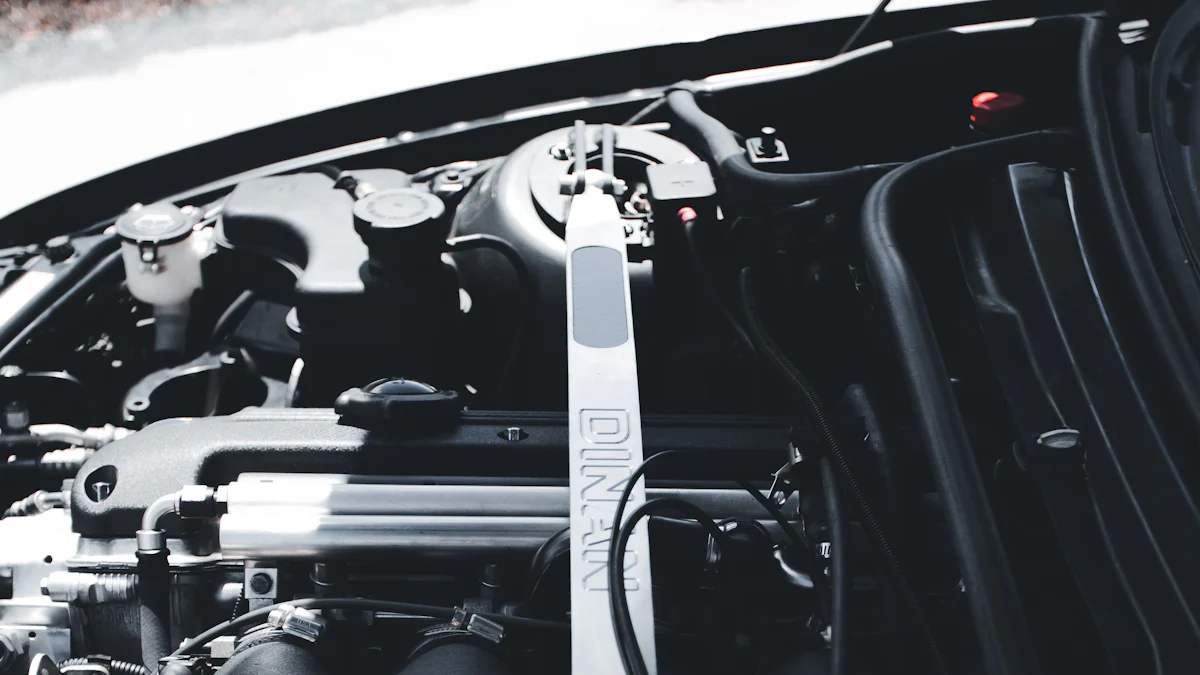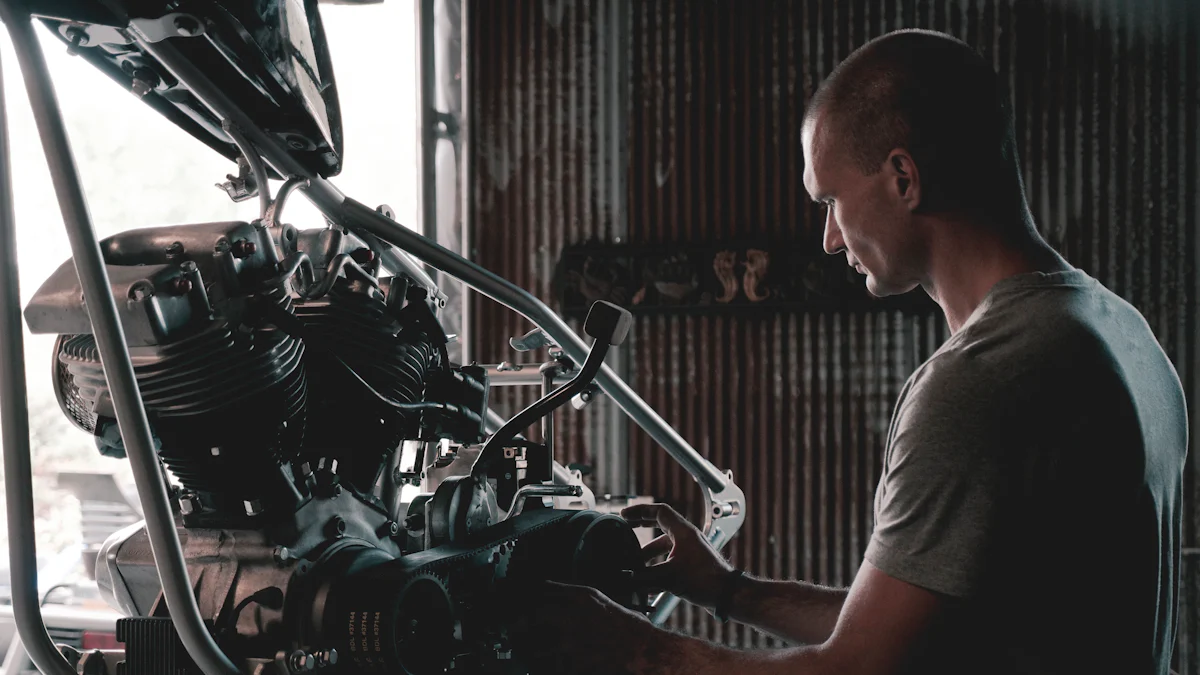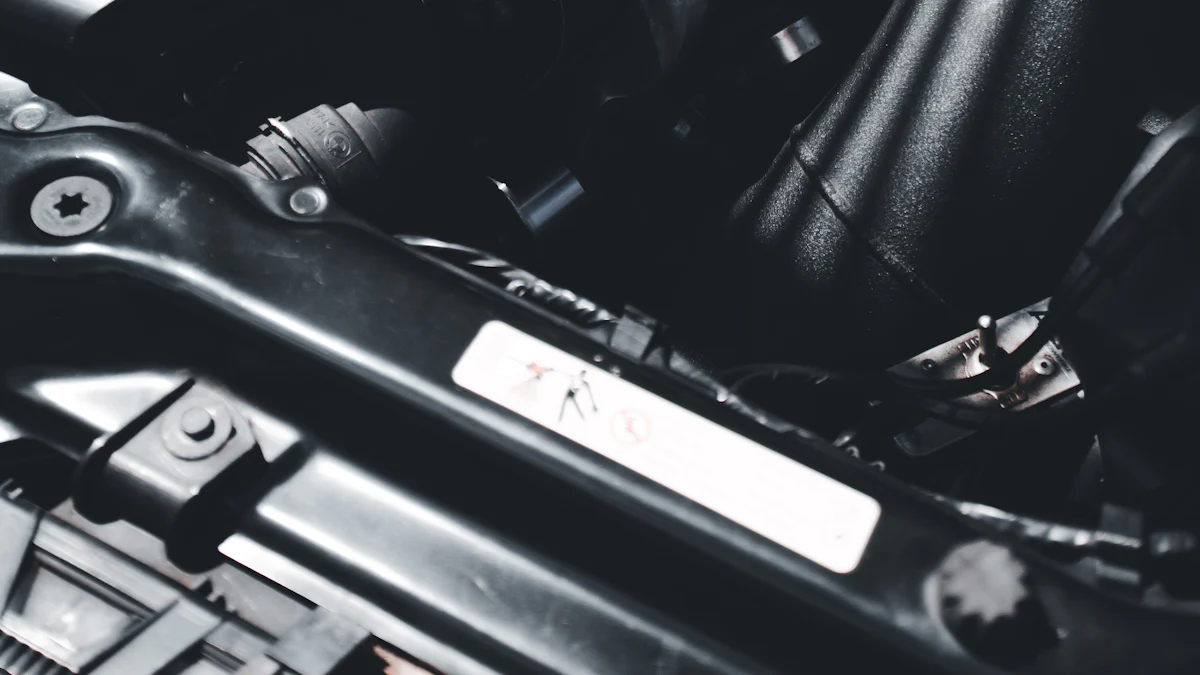
In the world of automotive engineering, understanding the Harmonic Balancer Crankshaft Pulley is crucial. The harmonic balancer, also known as a crankshaft damper, absorbs vibrations from the engine cylinders’ firing. This component protects the crankshaft and ensures engine longevity. On the other hand, the crankshaft pulley primarily drives engine accessories like the alternator and air conditioning. While both components are vital, they serve distinct roles. The GM Harmonic Balancer specifically enhances engine performance by reducing vibrations, contributing to smoother operation. Together with the Flywheel & Flexplate, these components maintain engine balance and efficiency.
The Function of a Harmonic Balancer

Understanding the function of a harmonic balancer is crucial for anyone interested in automotive mechanics. This component plays a vital role in maintaining your engine’s health and performance. Let’s explore how it works and what happens when it fails.
How Harmonic Balancers Work
Vibration Reduction
A harmonic balancer, often integrated with the crankshaft pulley, serves as a critical component in reducing engine vibrations. When your engine runs, it generates vibrations due to the firing of cylinders. These vibrations can lead to wear and tear over time. The harmonic balancer absorbs these vibrations, ensuring smoother operation. It consists of an inertia mass and energy-dissipating elements like rubber or synthetic elastomers. These materials counteract crankshaft harmonics, effectively dampening vibrations.
Engine Longevity
By reducing vibrations, the harmonic balancer significantly contributes to engine longevity. It protects the crankshaft from torsional distortion, which can occur due to intense vibrations. This protection ensures that your engine remains in good condition for a longer period. Upgrading to a performance harmonic balancer, such as the GM Harmonic Balancer, can further enhance your engine’s durability. This upgrade is especially important for modified engines, where controlling resonance and vibrations becomes even more critical.
Common Symptoms of Harmonic Balancer Failure
Engine Vibration
One of the most common symptoms of a failing harmonic balancer is increased engine vibration. You might notice excessive shaking, especially at high speeds. This occurs because the balancer can no longer absorb vibrations effectively. As the engine’s RPM approaches its resonant frequency, these vibrations intensify, potentially causing damage to various engine components.
Unusual Noises
Another sign of a bad harmonic balancer is unusual noises coming from the engine bay. You might hear knocking or rattling sounds, indicating that the balancer’s balance ring is no longer functioning properly. These noises can be alarming, but they serve as a warning that it’s time to check a harmonic balancer. Ignoring these symptoms can lead to more severe engine issues.
The Role of a Crankshaft Pulley
Understanding the role of a crankshaft pulley is essential for maintaining your vehicle’s performance. This component plays a crucial part in powering various engine accessories, ensuring that your car runs smoothly and efficiently.
How Crankshaft Pulleys Operate
Powering Engine Accessories
The crankshaft pulley connects directly to the vehicle’s crankshaft. It uses one or more belts to drive essential engine accessories. These include the alternator, power steering pump, and air conditioning compressor. As the crankshaft rotates, the pulley transfers this rotational force to the belts, which in turn power these accessories. This process ensures that your vehicle’s electrical systems, steering, and climate control function properly.
Belt System Integration
The crankshaft pulley integrates seamlessly with the belt system. Most pulleys feature a rubber ring between their internal and external parts. This rubber component helps dampen vibrations from the crankshaft, reducing wear on the belts and other connected components. Proper tension and alignment of the belts are vital for optimal performance. A well-functioning pulley ensures that the belts remain aligned and tensioned, preventing issues like drive belt edge damage.
Signs of Crankshaft Pulley Issues
Belt Slippage
A bad crankshaft pulley can lead to belt slippage. When the pulley loses its grip, the belts may slip, causing a loss of power to the engine accessories. You might notice a decrease in the performance of systems like the power steering or air conditioning. In some cases, the belts may produce squealing noises, indicating misalignment or poor tension. These symptoms suggest the need for a crankshaft pulley related repair.
Engine Overheating
Another sign of a failing crankshaft pulley is engine overheating. If the pulley fails to drive the belts effectively, the cooling system may not function properly. This can lead to increased engine temperatures, potentially causing severe damage. Regular inspection and maintenance of the pulley and belts can prevent such issues. If you suspect a bad or failing crankshaft, seek pulley related repair advice promptly to avoid further complications.
Differences Between Harmonic Balancers and Crankshaft Pulleys

Understanding the differences between a harmonic balancer and a crankshaft pulley is essential for anyone interested in automotive mechanics. These components, while often working together, serve distinct purposes in your vehicle’s engine system.
Functional Differences
Vibration Control vs. Power Transmission
A harmonic balancer primarily focuses on vibration control. It absorbs vibrations caused by the engine cylinders’ firing, protecting the crankshaft from potential damage. This component plays a crucial role in maintaining engine balance and efficiency. By reducing these vibrations, the harmonic balancer helps ensure the longevity of your engine, contributing to smoother operation.
In contrast, the crankshaft pulley serves a different function. It is responsible for power transmission. The pulley connects to the crankshaft and drives various engine accessories, such as the alternator and air conditioning. This component ensures that these accessories receive the necessary power to function effectively. While it also helps minimize excessive engine vibrations, its primary role lies in transferring power from the crankshaft to other parts of the engine.
Structural Differences
Material and Design Variations
The structural differences between these components are significant. A harmonic balancer typically includes a counterweight to externally balance the rotating assembly. This design helps it absorb vibrations effectively. The balancer often integrates with the crankshaft pulley, serving as a pulley for accessory drive belts. This integration allows it to perform dual functions, enhancing its utility in the engine system.
On the other hand, the crankshaft pulley is mounted on the outermost part of the crankshaft. It connects to the engine’s flywheel and flexplate, ensuring seamless power transmission. The pulley usually features a simpler design compared to the harmonic balancer. Its primary focus is on driving engine accessories, which means it does not include the counterweight found in harmonic balancers.
Consequences of Component Failure
When components like the harmonic balancer or crankshaft pulley fail, your vehicle’s engine performance can suffer significantly. Understanding these consequences helps you take timely action to prevent further damage.
Impact on Engine Performance
Reduced Efficiency
A failing harmonic balancer or crankshaft pulley can lead to reduced engine efficiency. You might notice that your vehicle doesn’t accelerate as smoothly or quickly as it used to. This inefficiency occurs because the engine struggles to maintain balance and power transmission. The harmonic balancer’s inability to absorb vibrations effectively can cause the engine to work harder, consuming more fuel and reducing overall performance.
Potential Engine Damage
Ignoring issues with these components can result in severe engine damage. For instance, a bad harmonic balancer can lead to rough engine vibrations, which may crack the crankshaft. Similarly, a faulty crankshaft pulley can cause drive belt tensioner problems, leading to belt damage. These issues can escalate, causing inoperative engine accessories and even complete engine failure. Continuing to drive with a damaged pulley or balancer increases the risk of a breakdown, leaving you stranded and facing costly repairs.
When to Seek Professional Help
Diagnosing Issues
You should seek professional help when you notice symptoms like engine vibration, unusual noises, or rough idling. A mechanic can diagnose the problem accurately, identifying whether the issue lies with the harmonic balancer or the crankshaft pulley. They use specialized tools and techniques to assess the condition of these components, ensuring a precise diagnosis.
Repair and Replacement Options
Once diagnosed, you have several repair and replacement options. If the harmonic balancer or crankshaft pulley is damaged, replacing it with a high-quality component like the GM Harmonic Balancer can restore your engine’s performance. Professional mechanics can guide you through the process, ensuring that the new part fits perfectly and functions optimally. Regular maintenance and timely repairs can prevent future issues, keeping your vehicle running smoothly and efficiently.
Maintenance Tips for Longevity
To ensure the longevity of your vehicle’s harmonic balancer and crankshaft pulley, regular maintenance is essential. These components play a vital role in your engine’s performance, and neglecting them can lead to costly repairs.
Regular Inspection
Visual Checks
You should perform visual checks on your harmonic balancer and crankshaft pulley regularly. Look for any signs of wear or damage, such as cracks or misalignment. Pay attention to the condition of the belts connected to the crankshaft pulley. Worn or frayed belts can indicate underlying issues with the pulley itself. If you notice any abnormalities, consider consulting a professional mechanic for further inspection.
Listening for Unusual Sounds
Listening for unusual sounds is another crucial aspect of maintenance. Start your engine and listen for any knocking or rattling noises coming from the engine bay. These sounds can be early indicators of a failing harmonic balancer or crankshaft pulley. Addressing these issues promptly can prevent more severe engine damage.
Professional Servicing
Scheduled Maintenance
Scheduled maintenance by a professional mechanic is vital for keeping your engine components in top condition. Mechanics have the expertise and tools necessary to assess the health of your harmonic balancer and crankshaft pulley. They can perform detailed inspections and recommend replacements if needed. Regular servicing helps catch potential problems early, saving you from expensive repairs down the line.
Expert Advice
Seeking expert advice is invaluable when it comes to maintaining your vehicle’s engine components. Mechanics can provide guidance on the best practices for caring for your harmonic balancer and crankshaft pulley. They can also advise on the appropriate intervals for belt replacement, ensuring that your engine accessories continue to function smoothly. Trusting professionals with your vehicle’s maintenance ensures that you receive accurate information and quality service.
By following these maintenance tips, you can extend the life of your harmonic balancer and crankshaft pulley. Regular inspections and professional servicing will help you avoid unexpected breakdowns and keep your engine running efficiently.
FAQs About Harmonic Balancers and Crankshaft Pulleys
Common Misconceptions
Interchangeability
Many people mistakenly believe that harmonic balancers and crankshaft pulleys are interchangeable. This misconception arises because both components often appear similar and are located in the same region of the engine. However, they serve distinct purposes. The harmonic balancer primarily reduces vibrations, while the crankshaft pulley drives engine accessories. Tom Taylor, an expert in automotive parts, emphasizes that using the wrong component can lead to engine inefficiency and potential damage. Always ensure you use the correct part for your vehicle’s needs.
Importance of Each Component
Both the harmonic balancer and crankshaft pulley play crucial roles in your vehicle’s performance. Pat Goss, from Goss’ Garage, highlights that neglecting either component can lead to significant engine issues. The harmonic balancer protects the crankshaft from torsional vibrations, enhancing engine longevity. Meanwhile, the crankshaft pulley ensures that essential accessories like the alternator and air conditioning function properly. Understanding their importance helps you maintain your vehicle’s health and avoid costly repairs.
Reader Questions
Addressing Specific Concerns
You might wonder how to identify issues with these components. Tom, a seasoned mechanic, suggests listening for unusual noises or feeling for excessive vibrations. These symptoms often indicate problems with the harmonic balancer or crankshaft pulley. Ben Scharff, another expert, advises regular inspections to catch potential issues early. If you notice any abnormalities, consult a professional mechanic for a thorough diagnosis.
Providing Practical Solutions
When faced with a failing harmonic balancer or crankshaft pulley, you have several options. Pat recommends replacing the faulty component with a high-quality part from a reputable source like CarParts.com. This ensures compatibility and reliability. Regular maintenance, as suggested by Tom, can prevent future issues. By following these practical solutions, you can keep your vehicle running smoothly and efficiently.
In a recent Episode of MotorWeek, Tom and Pat discussed the importance of these components in detail. They shared insights on how to maintain them and what to do when problems arise. Their advice is invaluable for anyone looking to extend the life of their vehicle’s engine.
For more information and expert advice, you can visit our investor site or check out resources from Chad Miller Auto Care. They offer comprehensive guides and support for all your automotive needs.
You now understand the distinct roles of harmonic balancers and crankshaft pulleys. The harmonic balancer reduces engine vibrations, ensuring longevity and smooth operation. The crankshaft pulley drives essential accessories, maintaining your vehicle’s functionality. Regular maintenance and timely repairs are crucial. Inspect these components often to prevent issues like excessive vibrations or engine damage. Share your experiences or questions in the comments. Your insights can help others maintain their vehicles effectively.
Post time: Nov-11-2024



